Dead Run
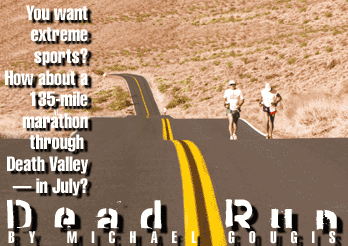
Originally published by New Times L.A. Aug 23, 2001
©2002 New Times, Inc. All rights reserved.
Vilma Mejia was vomiting, couldn’t keep fluids or anything else in her system. She had lost 17 pounds in about 12 hours. And she was starting to become disoriented, losing track of where she was and what she was doing. It would have been frightening to a young buck in boot camp, but Mejia was pushing 50, and she is a tiny thing—she didn’t have 17 pounds to give away to begin with. Her husband, Oscar, knew it was going to be difficult to get her to stop. Mejia refused to admit she had a problem, didn’t see anything so wrong with her that she had to quit. Oscar had to figure out a way to do an intervention, and fast.
“Get in the car, rest for a little while, then you can go on,” he told her as she approached Stovepipe Wells, 42 miles from the starting line. Mejia accepted his offer. She’d been feeling weak since about the 20-mile mark. Even though she’d been preparing herself mentally and physically for the heat, Death Valley had outstripped her worst expectations. When she’d left the starting line at 8 a.m. the thermometer read 120 degrees Fahrenheit. “At about 20 miles, it got really hot,” she said later. She waited a few moments in the car, tried to get some water to stay down, opened the door and staggered back out into the heat. The sun was setting. The temperature was bound to fall sooner or later. All Mejia had to do, she figured, was to keep moving. Secretly, though, Oscar had no intention of letting her leave Stovepipe Wells, a wide spot in the road that slices through the most famous desert in North America.
Oscar drove ahead and waited for his wife in the little town. He got her on a scale, and the weight loss was undeniable and alarming. She’d been pushing hard, doing miles in the 12-minute range when she was planning to average 15-minute miles, and the heat was making her pay for her speed. Mejia tried to rehydrate herself, tried to keep down water and Gatorade, tied ice in a bandana and put it behind her neck. But nothing worked. In some sports, athletes are allowed to refuel their bodies intravenously, but in this race an IV drip means instant disqualification. Oscar told his wife, ever so gently, “You have to stop. You cannot go on without hurting yourself.”
Vilma Mejia is not prone to yelling and cursing, but she is insistent. She tried to reason with her husband, tried to convince him it would be OK. But Oscar, a physical rehabilitation specialist, refused. Vilma didn’t take that well. She fumed silently for a moment or two. Then she turned to her husband and said, “OK, if I can’t keep going, at least drive me to the finish line. I want to see it. I want to be there.” So they headed across the desert, then up the slopes of the highest peak in the lower 48 states, Mount Whitney. There they waited. Twenty-five hours and nine minutes after the 135-mile race began, Russian Anatoli Kruglikov crossed the finish line, setting a new record and winning last year’s Badwater Ultramarathon.
The contest, sanctioned by West L.A.-based adventureCORPS, which promotes extreme sports, sounds insane. It is the equivalent of more than five back-to-back marathons through the hottest place on Earth in freakin’ July, where the ground itself burns you and the air is so dry that your glasses won’t fog when you breathe on them—the suffocating heat vaporizes the tiny droplets of moisture almost immediately. The start is at Badwater, the lowest point in North America; the finish line is two valleys away, a mile and a half in the sky. If a prison warden tried to make his inmates do this, the courts would have his scalp. Yet since Al Arnold first made the run in 1977, hundreds of runners have attempted to follow his footsteps, voluntarily putting themselves through the kind of physical abuse prisoners of war rarely see—the Badwater run is more than twice the distance of the Bataan Death March.
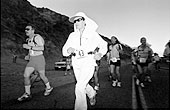
Every ultramarathon is hard. Badwater, however, has heat unlike anywhere else on the planet. A few years back, four Navy SEALs had applied to run the race, but were rejected because they didn’t have experience in running ultras. As race official Phil Marchant put it, “Just running a marathon doesn’t qualify you to do this.” The SEALs attended a pre-race meeting, and, Marchant recalled, “They stood up and said, “We officially protest; we are as badass as anyone here; we defend you and your country.’ So the organizers let them run that year. Three of them dropped out by Stovepipe Wells, and the last one not far after that.” If you can pull this off, you really have gone somewhere, emotionally and physically, where few people have gone before. When the boys or girls start slinging the machismo over brewskis, you will always have the final word. And even if you never say a word about it to anyone, you will have proved yourself capable of the closest thing to impossible many people can imagine.
Vilma Mejia, who lives in Glendale, sees herself as an example to women in countries where female athletics are discouraged. “I want them to see how much I enjoy this, that anything is possible,” she says, explaining why she runs. But that other reason, to prove to herself that she can, explains better why she had taken another week off from work and dragged her husband and daughter out of bed and into the car at 6 a.m. They headed east on the 10 Freeway, up and over the Cajon Pass on Interstate 15 toward Las Vegas and out to Baker, where they hung a left at the world’s biggest thermometer and sped into the shimmering desert heat. The temperature wasn’t too hot this July day, barely into the hundreds. A promising sign. Ahead was the pre-race meeting and then some rest overnight. The next morning, Vilma Mejia would once again, in Pink Floyd’s words, set the controls for the heart of the sun. The desert owed her one.
“Don’t think about the 135 miles in front of you. Don’t think about the 130-degree temperatures. Don’t think about the 13,000 feet of uphill,” Chris Kostman tells the 22 runners gathered at Badwater for the 8 a.m. start. There is nervous laughter from the group. It will be the last time some of them will laugh for days. Already, runners from the 6 a.m. starting group are miles down the road; the leaders are pounding out a torrid pace, determined to put in some miles before the temperature really rises. All told, 71 ultrarunners from nine countries start the race. Each has either completed a 100-miler or two 50-milers within a calendar year. Mejia is all smiles, gold hoop earrings and lipstick. She didn’t sleep the whole night through. “I woke up a couple of times; I am so excited,” she says before heading to the start line. Her husband kisses her and wishes her the best. “Be calm,” he tells her; she nods, barely hearing. A Marine major has brought a boom box with the “Star-Spangled Banner” on a tape. Everyone stands at attention as the music plays. Then Kostman leads a countdown back from 10, shouts “BANG!” and, in the shadows from the nearby mountaintops of Dante’s View and Coffin Peak, the field heads off.
It wasn’t burning hot at the start in Badwater, where a few brackish ponds lie still at the edge of the salt deposits that make up much of the dry lake bed at the bottom of Death Valley. The road is flush against a cliff that casts a welcome shade. But a few miles down Highway 178 the road snakes west, and as the sun comes up, the shade disappears. Not only are intravenous drips outlawed, so are any methods of protecting the runners from the sun other than sunscreen and clothing. And as the sun beats down, the mercury soars. Five miles from the start, just to the west of the road, is a salt flat known as the Devil’s Golf Course, where bowling ball-size chunks of darkened salt crystals dot the landscape for miles around, expanding and contracting as the heat rises and falls. If you are quiet, you can hear the earth itself play a metallic, Phillip Glass-like composition as the crystals crack and ping in the searing heat.
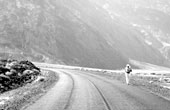
It is here that the desert claims its first victim. Klaus Schicktanz, 49, of Germany, an accomplished ultramarathoner, flew halfway around the world for this event, only to drop out after five miles. “His crew member came in, handed us his bib and said he was out, no explanation,” says Keith Kostman, the race director’s brother and one of the staffers at the first timing station, in Furnace Creek. It isn’t as hot as last year, but it is hot, and the breeze that is starting to pick up isn’t helping any. Wind merely dries off runners and dehydrates them more quickly.
Vilma Mejia, like most, is alternating between running and walking, changing occasionally to a fresh pair of shoes that Oscar and her daughter Virna keep in a cooler in the back seat of their rented car. Chilled shoes are a godsend when the pavement temperature reaches 200 or higher. Most runners have a “foot box” stuffed with bandages, scissors or razor blades to cut away blisters, and antiseptics and other medicines designed to keep the feet usable. Everyone has their own philosophy of foot care. Some runners swear by a pair of nylons under their socks; some slather their feet with Vaseline; some swathe them with duct tape. The leader, incredibly, is wearing a pair of black surf booties—thin-soled slip-ons normally used to protect feet from pebbly beaches.
“I want my jacket—wet,” Mejia shouts to her daughter, who soaks a lightweight long-sleeved white pullover in water and hands it to her mom as she walks by. Vilma also wears a long-billed white cap with a neck drape that makes her look like a pint-sized French Foreign Legionnaire. She heads on and Virna, a distance swimmer, shakes her head. “I wouldn’t do this race, period,” she says.
The human body in motion is like a controlled nuclear reaction—too little fuel and the reaction dies, too much heat and the core melts down. It’s not just a matter of pushing water into your system, but carefully replacing what the sun and biomechanical effort leaches from your body. Most runners keep careful track of how much weight they are losing and have calculated, for example, the percentage of that loss that is sodium. Water is critical; sports drinks are critical in the right amount. But too much of either can lead to nausea, and that leads to an entirely different set of problems.
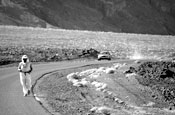
Mejia is relying on a diet of ramen noodles and baby food to supplement the fluids she is drinking on a regular basis; the soft foods are easy for the body to digest, leaving energy to the muscles. She uses long, white, lightweight clothing to keep the sun off her skin and her body cool. Other runners take a more direct approach. Their crew members—the better-equipped runners have two or more chase vehicles, often minivans and SUVs rented in Nevada—follow along with squirt bottles, wet rags or Supersoaker water guns, trying to keep their competitors in the game.
Sixteen miles from the start, Highway 178 meets Highway 190 and the runners bear left. They’ve come up 282 feet from Badwater to sea level, then dropped down 191 feet again for another mile into Furnace Creek, an oasis where coyotes prowl the seemingly out-of-place palm grove. The temperature is 108. Most of the runners still look relatively fresh, still smiling and waving enthusiastically to passersby wishing them well. Not all of them will look so good at the next timing station 25 miles up the road.
If Mejia had been taller, she might never have entered a five-kilometer fun run, let alone ultramarathons. Mejia stands only about five-foot-two. That was tall enough to allow her to be competitive in high school basketball in Peru, where she grew up. But as an adult she couldn’t find a league that fit her near her Glendale home, where she and Oscar have lived for 23 years. The kids were out of the toddler stage and her two daughters were taking gymnastics.
“When they’re young, you get your exercise chasing them, so I had been active, but when they got older, I had nothing to do,” she says. Even Oscar was spending his evenings at the local YMCA, playing something called “pickle ball”—similar to tennis except it’s indoors and there’s a heavy plastic ball involved. Vilma was aching for something athletic to do. So one morning in the late 1970s, she got up and wheezed her way around the block. And the lives of her entire family changed.
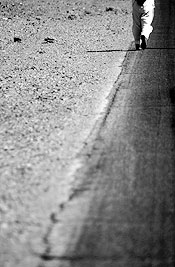
Mejia’s competitive streak flared up when it combined with her morning jogs. At first, it was five-kilometer runs, then ten-kilometer runs, then half marathons. By 1990, she’d done the L.A. Marathon and was looking for bigger challenges. She was bicycling, had started swimming, and was hunting around for short triathlons to enter. It may seem extreme, but pouring many hours into her training doesn’t seem to have had any ill effects on her life in general. She was getting promotions at work. Nowadays, she investigates financial fraud for Bank of America, working at a 14-story skyscraper in Glendale that provides a useful environment for her midday workouts, and she says the job of tracking down cheats and thieves is mentally challenging. “People put so much effort into trying to cheat, and they get so little in return most of the time,” she says. Her daughters were doing well in school, moving on to college. And Oscar—well, truth be told—Oscar was getting a little nervous when she started talking about triathlons.
“When she brought this up, I said, “Are you sure?’ Running a marathon is one thing, but swimming that distance is something else,” he said, recalling his fear for his mate’s physical well-being. “But once I saw that she could do it…” he shrugs. One gets the feeling he’s learned not to stand in her way too often. But when he does, she listens.
Mejia’s first ultramarathon was the Angeles Crest 100 in 1991, a 100-mile race along the highway that traverses the Angeles National Forest. It remains her favorite ultramarathon experience. “People knew it was my first, and they were cheering me the entire way,” she recalls. And, it being her first, there was little pressure in the way of expectations—she just wanted to finish. She nearly didn’t. At about the 48-mile mark, she tripped and fell, dislocating her thumb. She popped it back in and kept running. And she finished.
When it comes to ultramarathons, distance isn’t the only factor that determines the degree of difficulty. In April 1994, she was running a 50-miler in the hills east of San Diego when Mother Nature got nasty. “The weather was terrible. It was raining and snowing at the end. There was a scale at one of the checkpoints, and when I tried to get on the scale I was totally shaking, my fingers were completely blue,” she says. “It was the first time I ever have hypothermia. I was—how do you say this?—very, very, disoriented.” Mejia still struggles occasionally for the exact English word she needs to get her point across. “I was not doing well at all. My friends took me to a restaurant and fed me soup.” Four months later, she ran a 50-miler in Malibu without problems. “Every run has its risk. You just have to be ready to deal with them,” she says.
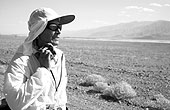
Getting ready means the alarm goes off at 3 a.m. in the Mejia household. Vilma’s up first, doing a few calisthenics, then Oscar drags himself out of the bedroom and they’re in the car, heading toward downtown Los Angeles. Vilma used to work in the Bank of America building there, and she shows up most mornings to leave food for some stray cats she’s fond of. Then she runs through Griffith Park back to Glendale for a shower and breakfast before heading for work.
Mejia wears her jet-black hair short, and a pair of gold hoops typically dangle from her ears. Miles of road work have left her lean, with a body fat content of as little as 2 percent at times. Her body is so fit that the last time she had a checkup, her nurse was taken aback. “She tried to take my pulse, and she did it again, and then she dropped my wrist and ran from the room,” Mejia recalls. “She brought another nurse in, and they did it together, and they ran out again. Finally, a doctor came in and asked, “Are you an athlete?'” Her resting heart rate was about half that of a typical adult her age.
Getting ready means training during lunch, and that can mean some odd looks from her co-workers. When she’s training seriously for an upcoming event, she spends her lunches jogging up and down the stairs of the skyscraper, eating as she goes. “I have to eat while I’m running, so it’s good practice,” she says. But her co-workers have gotten behind her. On many of the ultras, the organizers post regular updates on the runners’ progress on the Internet, and on her last one, co-workers hung a banner across the office and charted her progress.
After work, Mejia changes and heads back out on the road for another 14 miles or so. She tries to get in 20 miles a day, taking Wednesday evenings off to spend time at the gym. When a desert race like the Badwater is coming up, she tries to prepare for the heat by piling on the clothes. On one recent hot evening in Glendale, she was wearing long black Lycra tights, a shirt, a long-sleeved turtleneck, and a long-sleeved hooded shirt. A few days later she added a raincoat to the ensemble. On the bright side, she’s not really worried too much about her diet, confessing to an addiction to french fries from Islands and In-N-Out.
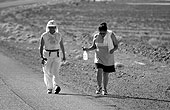
It sounds like there’s little time for family. But in an odd sense, this obsession has brought them together. Oscar is his wife’s coach, her confidant. When she wants to train on uphill sections, he’s following her in the car at 3 a.m. to make sure she’s safe. And at least once a year, Vilma and her two daughters get together and do a relay triathlon as a family. Oscar occasionally joins his wife on a short—emphasis on short—bicycle event.
But the strongest bond Vilma and Oscar have formed through years of this has to do with the trust she places in her husband’s judgment. In a way, Vilma has a mental short-circuit that allows her to accomplish what she does. “Most people think they cannot do something, and they give up without ever trying,” she says. “I cannot think that I cannot do something.” The downside of such a mindset is that when she pushes beyond her real physical limits, into territory where serious damage is possible, she ignores the warning signs. She doesn’t trust her own mind, her own body, when they are crying for her to stop. But she does trust Oscar.
Major William Maples, USMC, 37, clad in long white pants and jacket, walks up to the table alongside the general store in Stovepipe Wells. “Runner 13 checking in,” he says. “Can I sit down?” He drops heavily into a folding chair in the shade of a portable canopy, breathing quietly but hard; his eyes have the glazed look of a prizefighter who’s taken one too many shots to the head. He declines water; he declines the offer of an ice-filled bandana draped around his neck. “I’ll be OK, I’ll be OK,” he gasps. “I’m just going through a bad stretch.” After a few minutes, he gets up and walks across the street to a motel swimming pool, where he collapses facedown in a lounge chair and promptly pukes his guts out.
He isn’t the only one suffering. Between Furnace Creek and Stovepipe Wells are probably the nastiest 25 miles of the race. As
the day wears on, Death Valley’s heat builds on itself like a huge natural convection oven. The heated air rising from the desert floor is replaced by cooler air coming down the mountain slopes, but they’re so hot the “cooler” air is superheated by the time it hits the valley floor. As runners trudge toward the sand dunes on the approach to Stovepipe, the temperature soars to 126 degrees.
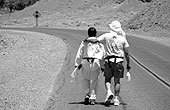
“A lot of the runners say that the real race begins here,” says Phil Marchant, one of the race staffers manning the Stovepipe timing station. For several runners, the race has ended here. In a cruel twist, the slower you are, the more time you have to spend in that vicious 25-mile stretch. As the sun crawls across the sky, dust devils hundreds of feet high dance across the desert floor like mad engraving needles; shadows grow long but the heat never seems to ease up. Fifty-one-year-old Errol Jones of Oakland, the race’s only African-American, ran the 17 miles to the first timing station in two and a half hours. He was the second-to-last person to make it to the second timing station, taking nearly 12 hours to make it across the last searing stretch of desert floor.
It is near this point where the scariest moment of the race occurs. Reg Richard, 50, of Pleasant Plain, Ohio, had made it past Stovepipe Wells and started up the hill out of the valley, but he was hurting.
It had been 10 hours since he last urinated, and if you’re not peeing in these conditions, especially with all the fluids you’re drinking, your kidneys are malfunctioning and you’re dehydrating. Suddenly, he collapsed in a heap in the cinders on the roadside. A crew member summoned paramedics, and a park ranger who also is an emergency medical technician arrived on the scene, where an argument broke out over the prostrate runner’s body. Richard was semiconscious. His crew wanted him to be allowed to continue, while the medical folks wanted him taken back to Stovepipe Wells to cool down and drink some fluids. Finally, race director Chris Kostman showed up and laid down the law: He didn’t want people killing themselves on his watch.
“This is my race, and this is what is going to happen,” he announces. He points at Richard. “He is going back to Stovepipe Wells. You are going to put him in a room and cool him down. If you try to go forward right now, he is DQ’d. If he leaves that motel before 10 tonight, he is DQ’d.” Richard is placed in the back of the ambulance and driven back down the hill to Stovepipe Wells. Between the ambulance and the door to his motel, Richard cuts loose with four projectile vomits. The last word on him at the timing station is that he has blood in his urine and is receiving medical attention.
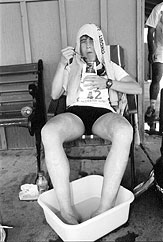
Not everyone is experiencing the same level of distress, but everyone is having some kind of trouble. Mejia is taking a beating from the sun; she’s resting for a few moments in the back of her rented Ford Taurus every three miles. She’s trying to balance between drinking too much and not enough, but she is struggling. Oscar and Virna, worried about Vilma’s condition, put an end to the balancing act. “Every five minutes now, you take Gatorade, and we will let things fall as they will,” Oscar tells her. Still, there’s hope for her getting to the finish line; she’s further along the course than she was at this time last year, and she’s actually in better shape than she was last year.
Sometimes the pain is much more personal, as Mark Henderson, 41, of Houston, finds out. Henderson, the aerospace project leader for the space shuttle, sports a pair of loose-fitting shorts that look like the Texas state flag. He is about 50 miles into the race, heading up the slope beyond Stovepipe Wells to the Towne Pass summit when he spots one of his support vans on the side of the road. “Nut butter! Nut butter!” he screams. A crew member whips a canister out of the back of the van and unscrews the lid. Henderson runs up, digs into the canister and comes up with a handful of what looks like runny petroleum jelly; with his other hand, he whips his shorts aside, exposing his boys to the breeze. His next act apparently relieves the chafing there to his satisfaction; he trots back across the road and up the hill, yelling, “Kickin’ ass, a mile at a time!” as he disappears into the fading sunlight.
At about the halfway point, John Quinn, 43, of Boulder, Colorado is well in the lead, pounding away in his flimsy-looking surf booties. He is six miles ahead of his nearest competitor. For fun, Quinn flies to France and competes in triple Ironman competitions that involve miles of swimming, hundreds of miles of bicycling and three marathon runs. By this point in the Badwater race, he’s been pumping out miles in eight minutes, 30 seconds for the length of nearly three marathons. But he’s in pain now. As he slows to a walk on the slight rise up to the third timing station at Panamint Springs Resort, he says, “Not enough miles on the legs in these conditions, and the [curvature] in the road is messing with them, too. We’ll get up to the time station and reassess. This place is kind of hot, but it’s something beautiful.” The swelling in his left knee is visible; his limp is painful to watch.
Nearly an hour back, Rudy Afanador, 42, a forklift operator from Medford, New York, is in second place, coming down the slope leading to the Panamint dry lake bed. He’s just passed a vista point from which Mount Whitney, 73 miles distant, is visible. And Afanador is trucking along, his strides long and powerful, looking more like a guy who’s done six blocks than 60-plus miles. His crew knows Quinn is struggling, and Afanador is hunting him down. But there is pressure from behind, although Afanador won’t know it for hours yet.
Every person who started this race may be an accomplished ultramarathoner, but some are more accomplished than others. Some of the stories border on the unbelievable.
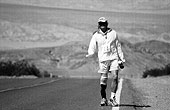
Take 39-year-old Chris Moon, of Hampshire, England. After a stint in the British army, he trained in mine-clearing and went to work in Cambodia, teaching former soldiers there how to clear minefields. In 1995, as he walked through a supposedly clear area, he tripped a mine. The explosion blew off his right leg above the knee and part of his right arm. Already a marathoner, he put on an artificial leg and kept going.
This summer is his third Badwater. This time, like last year, he is going to make it really hard. Anyone, he figures, can run from Badwater to the point where the paved road leading up Mount Whitney ends. Anyone can climb to the top of Whitney. But to turn around and run back to the start, now that would be a challenge. The British Broadcasting Corporation thinks so, too, and has dispatched a camera crew to track his progress through the desert for a documentary on a prototype artificial limb he is trying out.
Sunrise on the second day finds Afanador far ahead on the road. Quinn had made it a mile past the third timing station at Panamint Springs before his left knee blew out. He and his crew sit at the roadside for the next six hours, cheering the other competitors on. Sure, every group of athletes claims to be a family, that they’re brethren as well as competitors, but when you reach this level of competition, it’s more true than nearly anywhere else. There are far more people in the world with the ability to win the Indy 500, more quarterbacks who could win a Super Bowl, than there are people who have a real shot at winning the Badwater. And no matter how well you train, no matter how mentally prepared you are, doing this will hurt. These people know each other; on the road, they ask about the progress of those at the back of the pack as well as those breathing down their necks. One hundred twenty-two miles after the start, Afanador cruises past the final timing station in Lone Pine on Highway 395. It’s almost 26 hours into the event and he’s still running, his closest competitor on the road fading backward behind him.
But he isn’t in the lead anymore.
Young gun Michael Trevino, a 26-year-old San Diego computer geek, is coming to the front, and fast. The software applications engineer had been five minutes back at the first timing station and 37 minutes behind at the second. He’d started in the 10 a.m. group, meaning he’d spent more time running across the desert floor in the hottest part of the day. But in the evening, heading up and over the nearly mile-high Towne Pass, he ran perhaps the most amazing stretch of the race, surging into the lead. He’s up by 55 minutes at the fourth timing station.
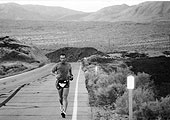
Only 10 minutes after Trevino zipped through Lone Pine, Afanador crosses the finish line 8,500 feet above Badwater at the Whitney trailhead, where temperatures barely make it into the 70s during the hottest part of the day. It is 11:03 a.m., slightly more than 29 hours after he started. Now the really hard part begins. He knows Trevino is way ahead on time. All Afanador can do is sip fluids and wait. He’s beaten everyone in his group, and has a huge lead on everyone from the 8 a.m. group. But if that damned Trevino kid shows up anytime before 3 in the afternoon, Afanador is taking home second place.
The wait isn’t anywhere near that long. Trevino crosses the line at 2:18 p.m., winning by 45 minutes, his eyes looking somewhat sunken, but he’s still standing, walking easily. Amazingly, Richard, the sick guy, has dragged himself from the motel room in Stovepipe Wells and back into the race. It takes him more than 12 hours to make it to the third timing station 30 miles away, then nearly 18 hours to make it the next 18 miles. But he finishes, crossing the line at 9:48 a.m. Friday morning for a final time of 51 hours, 48 minutes and 14 seconds. The final finisher makes it to Whitney with less than 20 minutes to go before the race officially ends at the 60-hour mark. Of the 71 starters, 55 have finished.
Vilma Mejia never saw the mountain.
At first, upping her Gatorade intake worked well. Then the cramping started, first in her thighs, then in her feet, a sign that she was dehydrating. But without an IV, reversing the dehydration process is slow, and nearly impossible when you’re also trying to run across Death Valley in July. Then the blistering started.
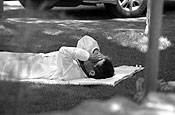
Mejia reached Stovepipe Wells dead last, in the middle of the night, and Oscar and Virna checked her into a motel. “I just want to rest for a half-hour,” she told her family. When they tried to shake her awake, she begged for another hour of sleep. When another hour had passed, she realized the race was over for her. There was no arguing; she was unable to get out of bed, her feet hurt so much she could barely walk, and her right hip throbbed because of the awkward gait she’d adopted to try to stay off the ball of her right foot. All she could bring herself to say was, “I don’t feel well.” Mejia was disappointed, but she’s hoping to try again next year.
It is ironic that Mejia’s race ended at the same spot as last year. She had been determined to finish this time. But out here in this place named Death, the desert doesn’t seem to remember that it owes her one.








